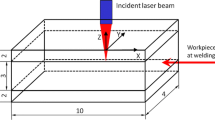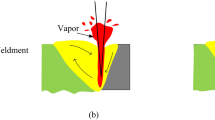Abstract
Inconsistencies between experimental data and concepts of the vaporization hypothesis, assuming melt displacement by the pressure of vapor recoil, are sufficient to doubt the applicability of this hypothesis for the simulation of deep penetration welding. In order to settle these inconsistencies, a hypothesis was proposed, including an associated model, which attributes the removal of the melt from the zone of the beam impact and the formation of a deep penetration channel to the action of tangential thermocapillary forces on a heterogeneously heated surface. The phenomenon of a deep penetration channel appears as a result at an excess of the threshold value of beam intensity, when the structural rearrangement of the thermocapillary divergent flow is observed, interrelated with a break-age of flow lines at the transition from the vortex mode to the shear mode. The thermocapillary model of deep penetration was verified by comparing the major parameters of the deep penetration process, obtained by calculations, with empirical data.
Similar content being viewed by others
References
V. P. Garashchuk, O. A. Velichko, and V. B. Davydova, “Influence of Average Illumination in Light Spot and Focusing for Deep Penetration at Pulse Laser Welding,” Avtomaticheskaya Svarka, No. 5, 31 (1971).
E. V. Locke, E. D. Hoag, and R. A. Hella, IEEE J. Quantum Electron. QE-8, 132 (1972).
R. Fabbro, M. Hamadou, and F. Coste, “Metallic Vapor Ejection on Melt Pool Dynamics in Deep Penetration Laser Welding,” Journal of Laser Applications 16(1), 16–19 (2004).
E. H. Amara, R. Fabbro, and A. Bendib, “Modelling of the Compressible Vapor Flow Induced in a Keyhole During Laser Welding,” Journal of Applied Physics 93(7), 4289–4296 (2003).
R. Rai, T. A. Palmer, J. W. Elmer, and T. J. DebRoy, “Heat Transfer and Fluid Flow During Electron Beam Welding of 304L Stainless Steel Alloy,” Welding Journal 88(3), 54–61 (2009).
R. Rai, P. Burgardt, J. O. Milevsky, et al. “Heat Transfer and Fluid Flow During Electron Beam Welding of 21Cr-6Ni-9Mn Steel and Ti-6Al-4V Alloy,” J. Phys. D: Appl. Phys 42, 1–12 (2009).
V. V. Semak, W. D. Bragg, B. Damkroger, and S. Kempka, “Transient Model for the Keyhole During Laser Welding,” J. Phys. D: Appl. Phys 32, L61–L64 (1999).
V. V. Semak, G. A. Knorovsky, D. O. MacCallum, and R. Allen Roach, “Effect of Surface Tension on Melt Pool Dynamics During Laser Pulse Interaction,” J. Phys. D: Appl. Phys 39, 590–595 (2006).
V. A. Batanov and V. B. Fedorov, “Ablation of Liquid Phase — New Mechanism of Formation of Crater at Flat Developed Vaporization of Metal Target by Laser Beam,” Pis’ma v ZhETF, 17(7), 348–351 (1973). (http//www.jetpletters.ac.ru/ps/1541/article23562shtml).
J. G. Andrews and D. R. Atthey, “Hydrodynamic Limit To Penetration of a Material by a High-Power Beam,” J. Phys. D: Appl. Phys 9(15), 2181–2194 (1976).
P. G. J. Klemens, “Heat Balance and Flow Conditions for Electron Beam and Laser Welding,” Appl. Phys. 47, 2165 (1976).
A. M. Verigin, A. A. Erokhin, V. N. Shavyrin, and V. F. Reznichenko, “On Value of Pressure of Steam—Gaseous Phase in Penetration Channel at Electron Beam Welding,” Fiz. Khim. Obrab. Mater., No. 2, 145–146 (1980).
A. A. Bondarev and N. M. Voropai, “On Forces Acting on Welding Bath at Penetration of Al-Alloys by Electronic Beam,” Fiz. Khim. Obrab. Mater., No. 2, 50–55 (1974).
W. Gatzweller, D. Maischner, F. J. Faber, et al., “Model of Dynamic Behaviour in Laser Beam Welding,” Proc. SPIE-Int. Soc. Opt. Eng. 1132, 157–165 (1989).
I. Myamoto, H. Maruo, and Y. Arata, “The Role of Assist Gas in CO2 Laser Welding,” ICALEO 44, 68–74 (1992).
A. N. Grezev, “Formation of Steam-Gaseous Channel of Welding Bath at Laser Welding,” Svarochnoe Proizvodstvo, No. 6, 13–17 (2005).
A. E. Zaikin, A. V. Levin, and A. L. Petrov, “Dynamics of Plasma of Near-Surface Oprical Discharge in Vapors of Metal in the Beam of Continuous CO2 Laser,” Kvantovaya Elektron., 25(2), 135–139 (1995).
E. A. Mitkevich, V. A. Lopota, and S. G. Gornyi, “Dynamics of Seam Formation at Welding by CO2 Laser,” Avtomaticheskaya Svarka, No. 2, 22–26 (1982).
M. Eissen and D. M. Keicher, “Optical Method of Penetration Sensing for Pulsed Nd-YAG Laser Welding,” Proc. SPIE-Int. Soc. Opt. Eng. 2993(2), 2–8 (1997). (http://www.osti.gov/bridge/product.biblio.jsp?query-id=0&page=0&osti-id=463677).
A. A. Vedenov and G. G. Gladush, Physical Processes at Laser Processing of Metals (Energoatomizdat, Moscow, 1985) [in Russian].
S. G. Gornyi, V. A. Lopota, and V. S. Smirnov, “Estimation of Losses by Vaporization at Determination of Efficiency of Laser Welding,” Avtomaticheskaya Svarka, No. 6, 72–73 (1988).
S. G. Gornyi, V. A. Lopota, V. V. Ploshikhin, et al., “Peculiar Features of Metal Vaporization at Laser Welding,” Avtomaticheskaya Svarka, No. 10, 64–65 (1986).
P. A. A. Khan, T. Debroy, and S. A. David, “Laser Beam Welding of High-Manganese Steel-Examination of Alloying Elements Loss and Microstructural Changes,” Welding Journal 67(1), 1–7 (1988).
S. G. Gornyi, V. A. Lopota, V. D. Redozubov, et al., “On Ultimate Characteristics of Laser Welding of Metals,” Zh. Tekh. Fiz., 57(12), 2390–2391 (1987).
R. D. Seidgazov and Yu. M. Senatorov, “Thermocapillary Mechanism of Deep Penetration into Materials by Laser Radiation,” Kvantovaya Elektron., 18(3), 396–398 (1988).
R. D. Seidgazov, V. G. Niz’ev, and V. E. Gofman, “On Mechanism of Displacement of Melt by Pulse of TEA CO2 Laser,” Poverkhnost, No. 3, 18–21 (1992).
R. D. Seidgazov, “Thermocapillary Mechanism of Melt Displacement During Keyhole Formation by the Laser Beam,” J. Physics D: Appl. Phys 42 (17 (175501)), 7 (2009).
E.-J. Ha, Y.-D. Kim, and W. Kim, Unified Analysis of Low-power and High-power Density Laser Welding Processes with Evolution of Free Surface. Annals of the Assembly for International Heat Transfer Conference 13, Australia, Sydney (2006).
B. C. Wood, T. A. Palmer, and J. W. Elmer, Comparison Between Keyhole Weld Model and Laser Welding Experiments. Report of Lawrence Livermore National Laboratory, September, 23, 2002.
A. G. Grigor’yants, Foundations of Laser Processing of Materials (Mashinostroenie, Moscow, 1989) [in Russian].
A. F. Banishev, V. S. Golubev, and O. D. Khramova, “Study of the Key-Hole Formation Dynamics Under High Power Laser Action Upon Metals,” Laser Phys. 1(6), 1198–1202 (1993).
C. Banas, “High Power Laser Welding,” Optical Eng 17(3), 210–216 (1978).
S. W. Pierce, P. Burgardt, and D. L. Olson, “Thermocapillary and Arc Phenomena in Stainless Steel Welding,” Welding Journal, Fabruary, 45–52 (1999). (www.aws.org/wj/supplement/Pierce/ARTICLE3.pdf)
Author information
Authors and Affiliations
Corresponding author
Additional information
Original Russian Text © R.D. Seidgazov, 2011, published in Matematicheskoe Modelirovanie, 2010, Vol. 22, No. 8, pp. 67–82.
Rights and permissions
About this article
Cite this article
Seidgazov, R.D. Thermocapillary mechanism of deep penetration in laser beam welding. Math Models Comput Simul 3, 234–244 (2011). https://doi.org/10.1134/S2070048211020098
Received:
Published:
Issue Date:
DOI: https://doi.org/10.1134/S2070048211020098




